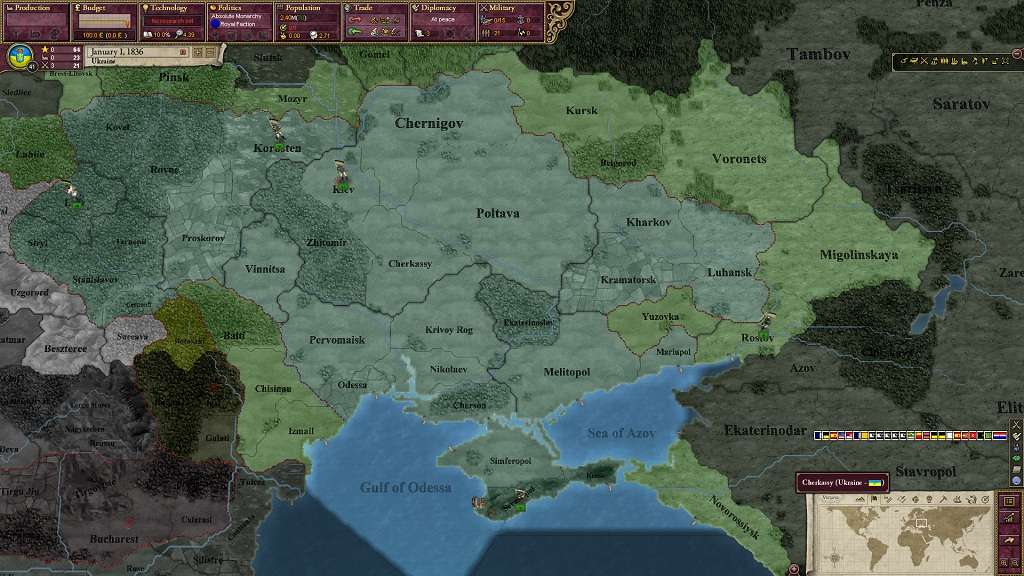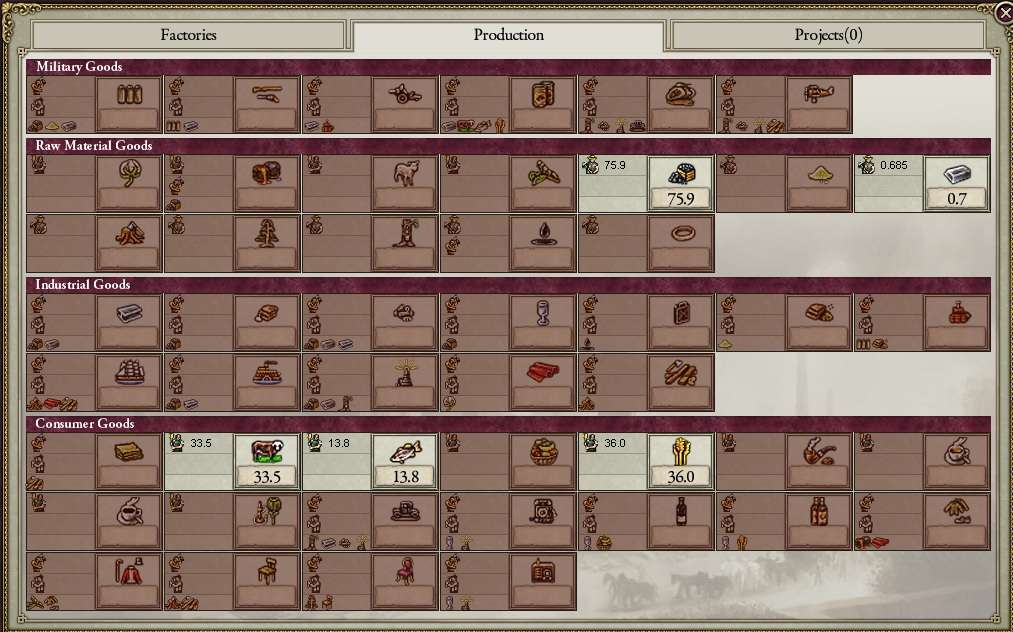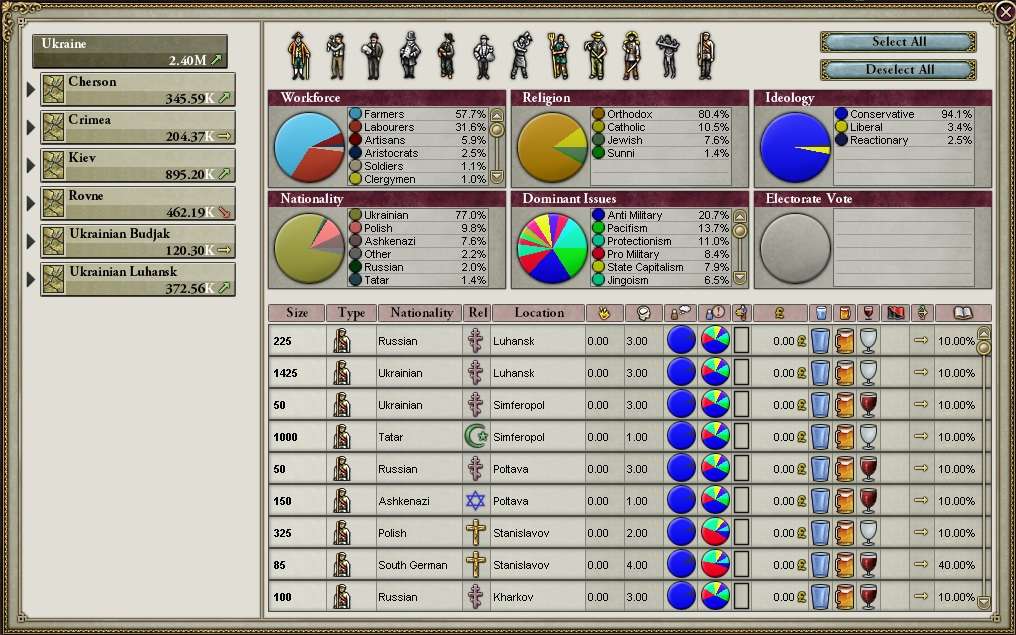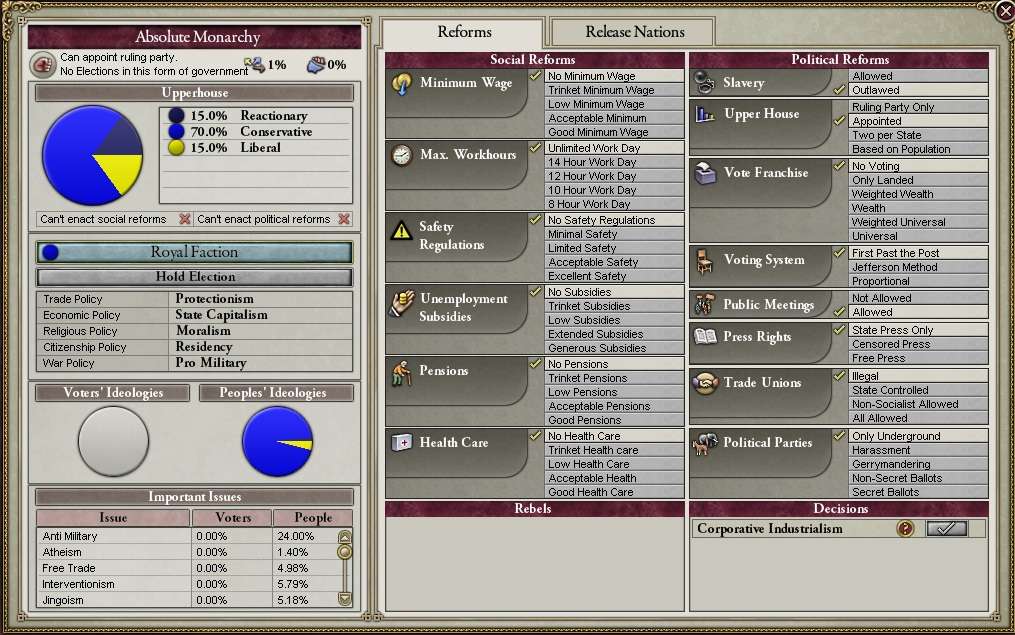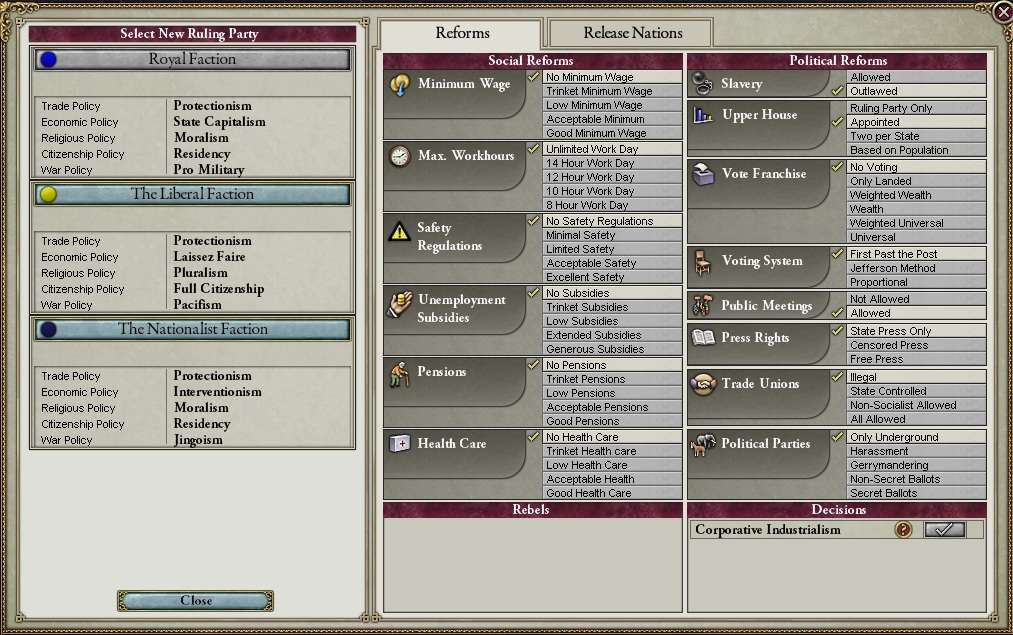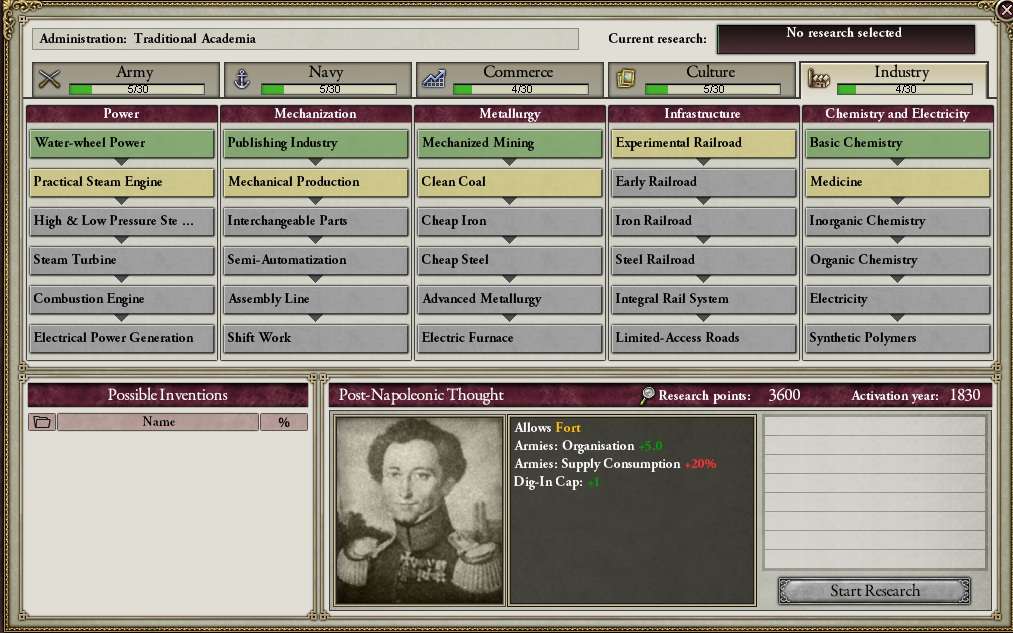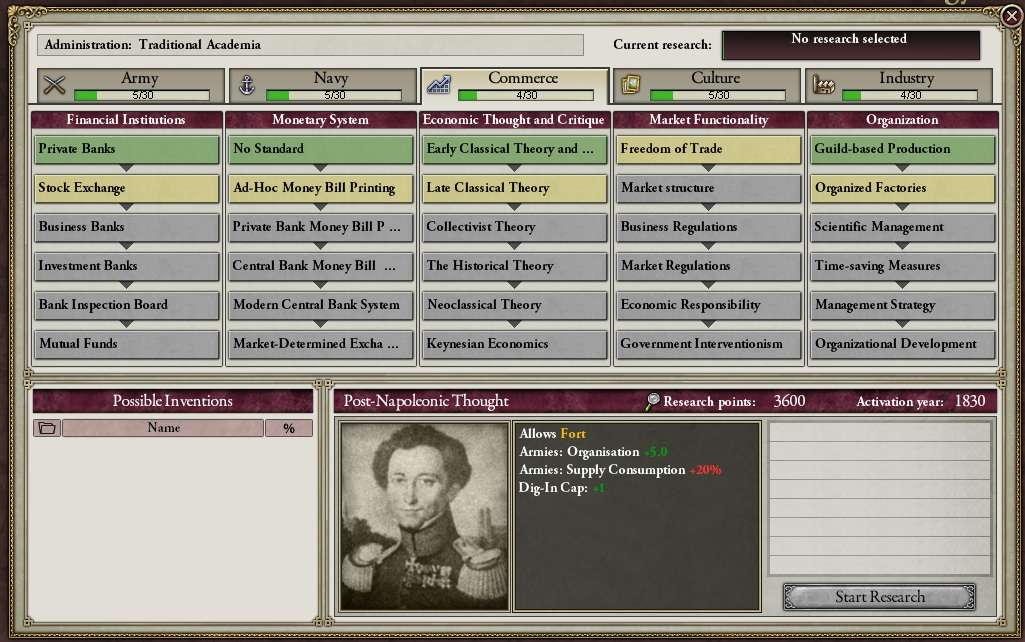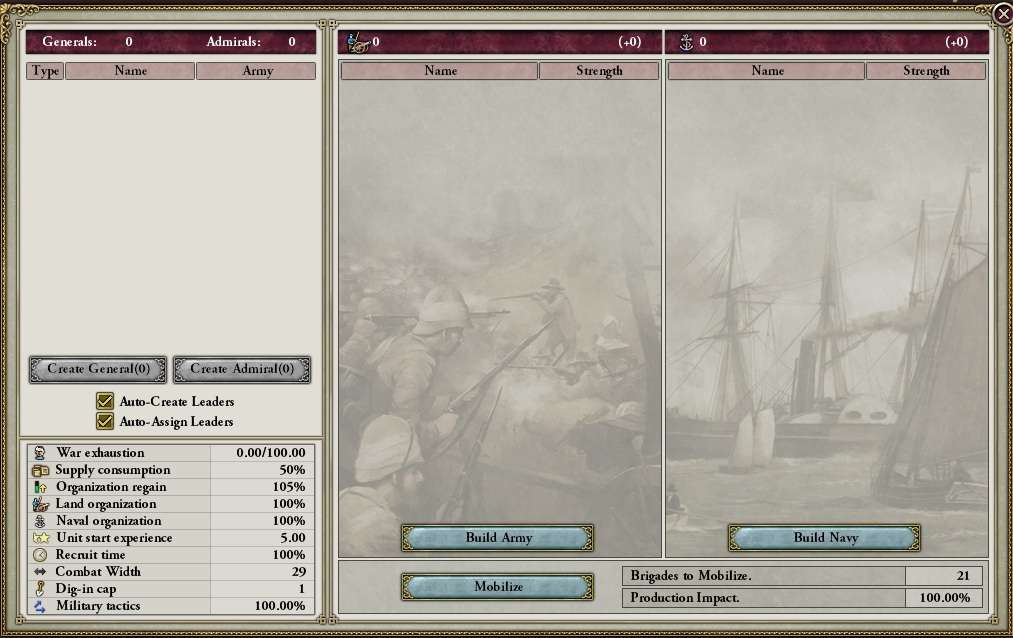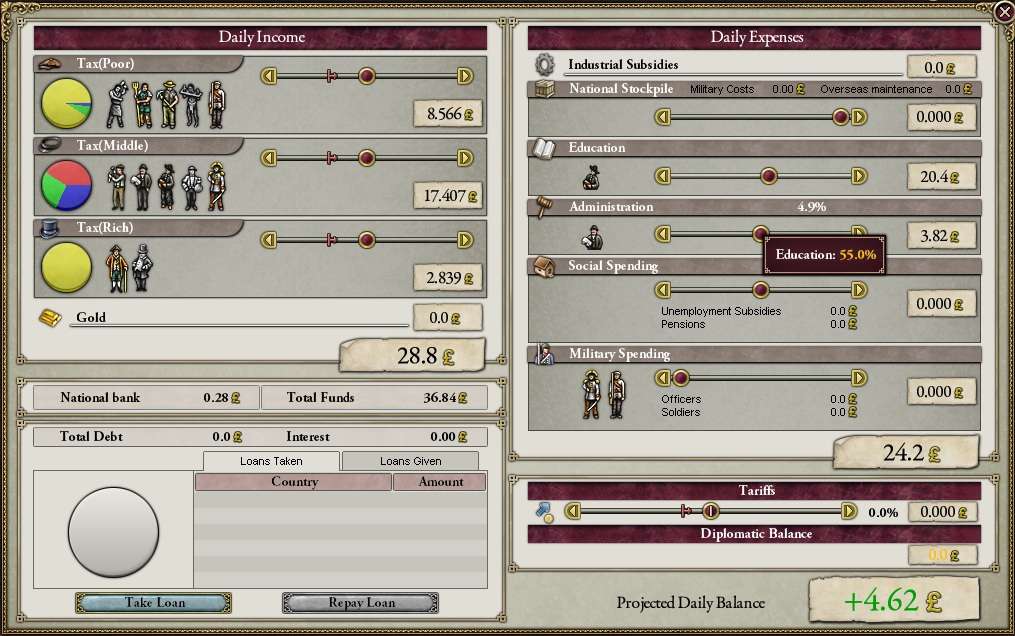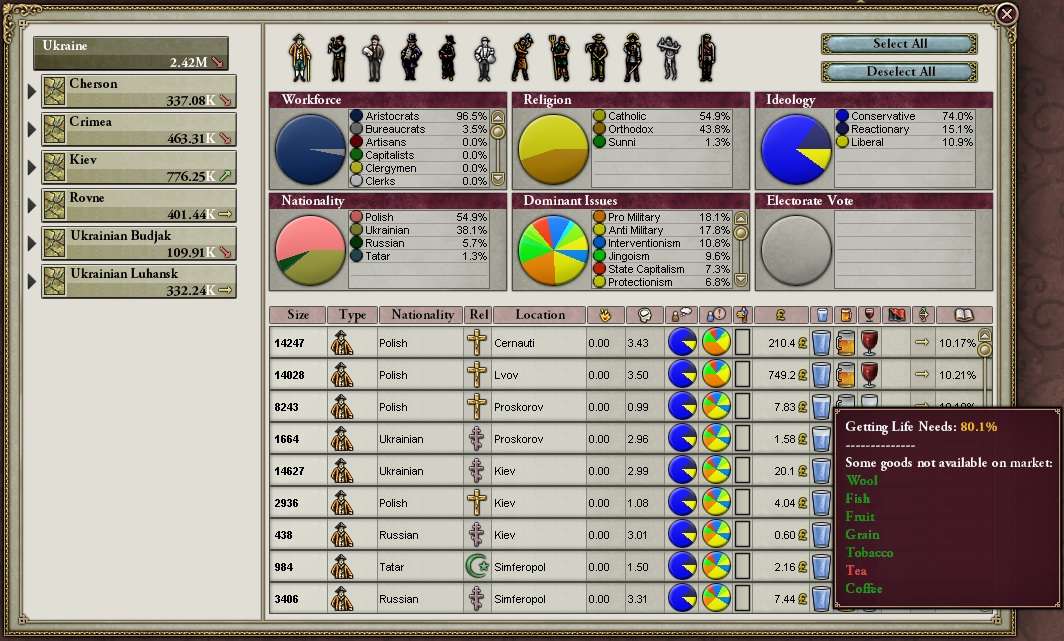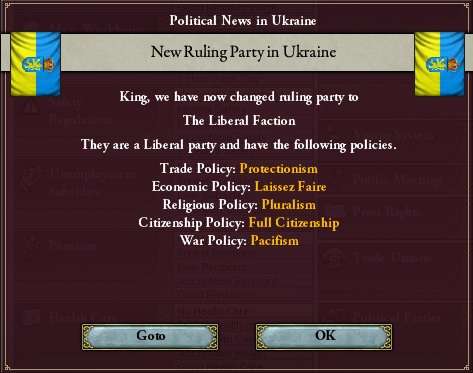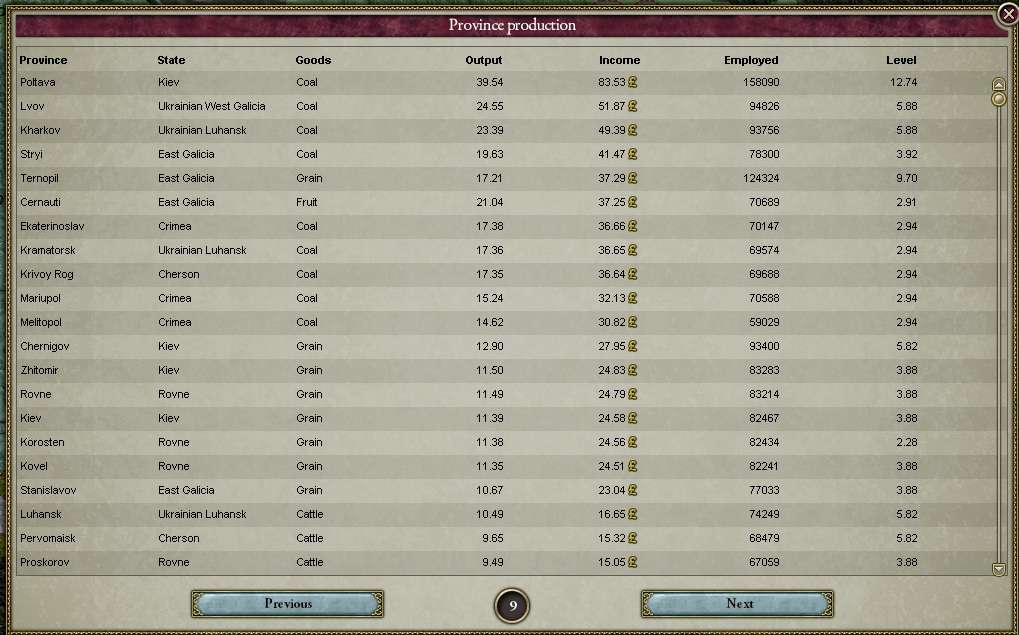Chapter 1: Meet Ukraine and her economy
Note: This first chapter will necessarily be quite text heavy. Since I'm partially writing this for new players, I may perhaps over-explain things: don't worry, there will be plenty of pictures in each update, although a bit fewer for this one.
In every game of Victoria 2, perhaps your first decision will be the first tech you choose. Many nations (the typical ones a player would choose to start with, like USA) have all the level 1 techs. Some uncivs (uncivilized nations) have zero techs to start out with. In my case, I choose one of the best techs for a starting civilized nation -- Freedom of Trade. Freedom of Trade gives you +50% to all your RGOs (Resource Gathering Operations -- your mines, farms, and wharfs). It'll take a while, with such low literacy (10%) and correspondingly low research points, but we should see a huge jump once it's finished.
The next opening move you'll want to determine is what to do with your first National Focus (NF). National Foci are incredibly potent ways to steer your economy or people (usually abbreviated as POPs) in certain ways. It's also how Secondary Powers (we'll get to that in a minute) colonize. You can have a possible maximum of 7 NFs by the end of the game. There are two requirements to have one -- 1) you need 1 million people of your primary culture and 2) you need the right level of technology. If you go under the Culture Tab, the appropriate technologies are in the Political Thought column. Ukraine has two NFs via tech (everybody gets one NF + one NF for the first level Political Thought tech), but we don't quite have two million people of Ukrainian culture, so we're stuck with just one NF. Since research will be a huge focus, it's a no-brainer -- Encourage Clergymen in Kiev. Clergymen are pretty important POPs, since they educate everybody else (increasing literacy) and determine your base rate for research points.
The last move we make to begin the game is to ask our Big Brother (The Russian Empire) for an alliance. It's considered Unlikely, but we get lucky and Russia agrees anyway. We do this for two reasons. First, Ukraine has no army at game start, and Russia provides us much needed protection and deterrence in case our other neighbors, Austria and the Ottoman Empire, get hungry and want a snack. Second, we'd like Russia to like us, so she'll put us in her Sphere of Influence (SOI). Before we move further, a few words about Diplomacy in Vicky 2.
Diplomacy in Vicky 2 is substantially different from other Paradox games, like EU 3. There are four categories of countries, determined by a composite of three scores: prestige, military, and industry. Prestige is earned from events, winning wars, and certain techs and inventions. Your military score is an aggregate of your military technologies, the size of your army, and the size of your capital ships (Man O' War, Ironclad, or Dreadnaught) -- other ships matter but not as much. Industry is your total factory output, which includes things like the size and number of your factories, your railroads, and the industry techs you have. The top eight countries in total score are Great Powers (to begin with, UK, France, The Russian Empire, Austria, Prussia, the USA, the Ottoman Empire, and Spain). Great Powers engage in constructing SOIs. A Sphere of Influence has both political and economic aspects: you get privileged access to your sphereling's economy and a
de facto alliance. Now, this cuts both ways -- the sphereling also gets privileged access to your economy (we'll talk about this more in a bit). This isn't like being a Satellite, where you are completely dominated by another power in foreign policy and have to pay substantial sums to the overlord nation. It's quite beneficial for both parties. In addition to having an SOI, Great Powers can also colonize, force other countries to repay debts after bankruptcy, and industrialize.
Next comes Secondary Powers, or the next eight in line after the Great Powers. They can colonize and industrialize, but have no SOI and cannot force countries to repay debts. Most of the rest of the countries in the game are Civilized Nations -- they can industrialize, but can't colonize, have no SOI, and can't force countries to repay debts. A select few are Uncivilized -- these poor countries can't even industrialize

. As an added penalty, uncivs cannot be Secondary or Great Powers, even if they have a total score that would otherwise put them there (China is a great example; they'd be a Great Power almost from game start if not for their unciv status). By researching certain level 1 technologies, and getting specific prestige and military scores, an unciv can "westernize" and become a civilized nation, at which point they can quickly leapfrog many other nations. Ukraine, at this point, is a garden variety Civilized Nation, ranked #41 -- with no prestige or military, we've got a ways to go.
Got all that? Good!

We unpause for a couple of days to let the economy "settle" -- every economy produces zero of everything to start the game, so you'll often be in the red to start a game. This is no cause for concern -- eventually, your POPs will get to work (lazy bastards) and start producing stuff, and you'll quickly get a more accurate budget. Here's our economy on January 1st, 1836 (I'm a dirty Yankee, so all dates will be American style

).
There's a lot of information here, but we'll go through it each piece at a time. One very important thing in Vicky 2 is that you have little direct control over your economy -- you just set the sliders in the Budget Screen and hope things work out. (I'm exaggerating a bit, but not as much as you'd think).
On the left, next to the three colorful pies, are your tax rates for your three classes, poor, middle, and rich. Some are greyed out -- Ukraine doesn't have slavery, and we have no Clerks, Craftsmen, or Capitalists at this point because we have no factories. We will soon! For now, I'll give you a quick rundown of what POPs are and what they do.
A POP represents a group of people in your country. Some POPs are large, others are quite small -- it depends on the culture, religion, and province of the POP. So, for example, Ukrainian Orthodox farmers in Kiev are one POP; Ashkenazi Jewish Bureaucrats in Poltava are another. The distinction doesn't have to be that big -- if you have Jewish and Orthodox Capitalists in Chernigov, for example, they each get their own POP. Every POP has a number of important characteristics, which we'll get to later on. You can manipulate POPs with a lot of time and/or experience -- we'll save that for another time. For now, here are the POPs and what they do.
Poor Class
Farmers: Farmers are usually your largest POPs to begin with -- they're 57.7% of all Ukrainians at the moment. They work in certain RGOs, most of which are obvious -- Grain, Cattle, and Wool, for examples, are all produced by Farmer-operated RGOs. Fish, oddly enough, are also produced by Farmers -- I suppose it's a similar skill set to raising cattle. For now, just accept it and move on
 Laborers:
Laborers: If it's an RGO and it doesn't have farmers, it has laborers. That's the only real distinction. It's the second biggest group in Ukraine at game start -- 31.6%.
Soldiers: Unlike HOI or EU, only certain segments of your population get to join the military, in this case soldiers. For every 3000 soldier POPs, you can produce one brigade in the army (for ships, the crews are largely imaginative). Thus, a POP with 12,000 soldiers can produce four brigades. Now, as soldiers are killed in combat, the POP naturally decreases -- if a POP gets small enough, it won't be able to reinforce one or more brigades until it's built back up again, through demotions or promotions.
Craftsmen: Factory workers. In most cases, you need to have the factories first, but as soon as you build a factory, Craftsmen will start appearing.
Slaves: If your society allows slavery (Ukraine does not), slaves are basically Farmers/Laborers, but they make no money and have no needs. If this sounds like a good deal (economically), they are less productive than the equivalent number of farmers or laborers.
Middle Class
Artisans: Before there were factories, there were artisans. Artisans buy raw materials on the open market and then build whatever they've a fancy to build. Artisans will give you some industrial goods -- they can even build automobiles, should you not have the factories -- but not nearly as many as you'd get with a factory. However, they pay for all the input goods and live off the profits.
Bureaucrats: Bureaucrats run the government, for the most part, from collecting taxes to fighting crime to making sure certain programs are carried out. They're important for colonies too -- we'll get to that later on. There's an optimal number of bureaucrats per state (a collection of provinces) and per country -- you can check any number of tool tips to find out. It won't be a problem for quite some time, so for now we'll leave that be too.
Clergymen: Your educators, as I said above. There's a max percentage of clergy that's useful -- 2% of your total population. They produce literacy, CON, and research points.
Clerks: Super-craftsmen and clergymen rolled into one. I have never once exceeded the threshold for these -- 4% of the population -- but they make craftsmen more efficient and provide base research points. They don't help with literacy, though, so you'll always need your friends in the clergy.
Officers: Officers don't actually fight in combat (only the grunts do), but you need a certain number of officers to make sure your military runs smoothly. For every 20 leadership points, which are produced by officers, you get one general or one admiral. The game will auto-create these for you, by default -- we'll talk more about leaders when we get into combat. There's an optimal percentage, but it's not fixed -- it grows as the army does.
Rich Class
Aristocrats: Aristocrats essentially "own" your RGOs. They take a portion of the profits from selling the goods. As you can imagine, they are highly dependent on lucrative RGOs to be successful and happy, something that is largely out of your hands. You can never have too many aristocrats -- they can greatly improve efficiency in a province.
Capitalists: They're aristocrats for factories, but much more. Unless you have a planned economy, they'll also pool money together to build factories and railroads and build them for you! They often make dumb decisions, but they are free, and there's no such thing as a bad railroad. If aristocrats are valuable, capis (as they're often called) are more so.
Now that we know what our pops do, we can go back to our budget. Next to the pies (we'll get to these later on) is the tax rate. Our current government has an economic policy of State Capitalism, which puts a floor on the tax rates of each class -- 25%. This is one way to gain revenue for the state, however, low taxes mean people can buy things they like, want, or need, and happy POPs are productive POPs. It'll take some time to strike a balance. All of our POPs start at a 50% tax rate. Until the economy settles, we won't mess with this much.
The other possible sources of revenue include Gold (Ukraine has none -- if you do, Gold goes straight to the treasury, so it's pretty valuable!), Tariffs (a tax on imported goods -- you can also use negative tariffs, or import subsidies, to make foreign goods cheaper for your POPs), Interest on loans (other countries will borrow money from you) and Indemnities, which countries sometimes pay you if you defeat them in war.
On the right side of the screen are the expenditure sliders. First, you have national stockpile. The national stockpile supplies your troops and your industry, when new things are purchased (like factories, railroads, forts, and naval bases). If you are a hands-on sort, you can manually buy some goods for your national stockpile. The AI normally handles this, and you probably should let it, for the most part. The main reason to do that is to insulate your economy from blockades. For our purposes, the slider will almost always be as far to the right as possible, or your soldiers don't get the supplies they need and lose Organization, which they need to fight well. In EU 3, you often cut the military maintenance slider when you're starting out to save cash. However, in Vicky 2, it can take quite some time to regain Org, so it's often a bad idea. I usually never touch this slider -- do so at your own risk!
The second slider is Education. This is what pays your clergy. The higher it is, the more clerks you get (and the better stuff they can buy). Ideally, this would be at 100% until you get 2% clergy, then you can cut it if you want. For now, we'll bump it up to 55%, since we still need a surplus to start building factories.
The third slider is Administration. This is what pays your bureaucrats. It also determines crime fighting and certain programs (minimum wage, for one). Even if you have more than the recommended number of bureaucrats, decreasing this can be counter productive, as you could have crime. However, that is determined at the state, and not national level. The number, 4.9%, is the Administrative Efficiency. The most you can have, to begin with, is 39.5% with 100% spending and the max number of bureaucrats. Technology adds to this -- I don't think 100% efficiency is attainable, but you can certainly do better. We'll leave this one at 50% for now, although it's a priority to bump this up.
The fourth slider is Social Spending. Unemployment and pensions are paid through here -- we don't have either to start, and won't for some time, so it's irrelevant what you set it at for now.
The fifth slider is military spending. Now, military spending pays your soldiers/officers. This determines a) what goods they can buy and b) how many soldier and officer POPs you have. Soldiers are equally effective regardless of how much you pay them -- the national stockpile takes care of them while they're in the army. However, a low slider means fewer POPs, and if soldier POPs starve when they aren't in the army, they could switch jobs. I am 99.999999999999% sure that military spending is totally irrelevant for brigades you already have [please, readers, feel free to correct me on this, I know it's a little obscure at the moment!] We have no troops, so we'll leave it at zero for now.
The last slider on the right is Tariffs. Tariffs serve two purposes -- gaining revenue and affecting prices for foreign goods. Here's an example [numbers are made up for ease of calculation]: Say you're looking at Timber, an important raw material (and one that Ukraine does not possess, I'm afraid

). Now, one unit of timber costs 10 pounds, we'll say. With zero tariffs, if a POP wants timber, he'll buy it wherever he can get it. If there's some on the Internal or Domestic market (what you and your Sphere produce, whether you own the sphere or just are a part of it), he'll always buy that. The POP (hypothetically) walks over to the timber RGO, pays his 10 pounds, and walks away. Simple enough. If there's a 10% tariff, and you have timber on the Domestic Market, no sweat, he still pays the 10 pounds. Now, if there isn't enough there, he has to buy it on the Global Market (access to which is controlled by prestige; the more prestigious your country, the higher up in the pecking order you are) for 11 pounds, of which the government keeps 1. Now, since this happens for all goods, it can be quite devastating if you use tariffs recklessly for revenue, particularly if you can't buy key goods because you don't have the prestige. For this reason, I personally use tariffs for short term revenue; if I need some quick cash for a factory or improvement I need very badly, or need to pay off a loan or fight a quick war. Your mileage, of course, may vary!
There is one other area that you change in another area -- industrial subsidies. If a factory is subsidized and can't afford to buy inputs, the government pays for it, with a corresponding increase to daily expenditures. There's plenty of reasons why you might do this -- for now, just accept that you can, and we'll discuss why later on. You may not be able to subsidize at all, if your ruling party has a Laissez Faire Economic Policy -- for now, that doesn't apply to Ukraine, so we'll move on.
Whew! That was a lot of explaining, wasn't it? I'm telling you all of this now because it will make the rest of the game make a lot of sense -- we'll spend a lot of time here, because it's one of the few ways I can effectively control the country without letting it drift.
The upshot of all this meddling is that we make 4.62 pounds a day, based on prices in the world at the moment. Since prices are constantly shifting (as is production), quite dramatic fluctuations are quite normal. You generally want to build a considerable stockpile of cash to insulate yourself from the normal boom/bust cycle, to pay for wars, or to build improvements to your territory. You always to stay "green" (+ cash flow) whenever possible, but huge amounts of surplus can usually be better spent instead of accumulated, either by cutting taxes or tariffs, or building important stuff.
Dramatic drops usually happen for three reasons. First, if you're a small economy (like Ukraine) and a good gets hugely oversupplied, the so-called "price bubble" will "burst," which could be a dramatic drop in price. This could be temporary or permanent -- you may want to ride it out and see what happens. Second, you just spend a bunch of money on troops, factories, railroads, or improvements. Each one of these has a flat cash cost and then a certain amount of stuff you need to build it. The extra stuff, if it isn't already in your stockpile, will be added to your stockpile and a temporary spike in expenditure will happen. After a few days -- when you've got the stuff you need -- this will drop back down. Third, you started a war, which drastically increases the amount of stuff you need to supply your troops.
So, we'll unpause the game again.
January 15, 1836: France declares war on Tunis. Blast! Tunis is usually an easy target for Ukraine -- there's some quality raw materials to be had there -- but without an army or a fleet (yet), we have to leave this alone for now.
February 21, 1836: Our economy is doing quite well! We've got 742.7 pounds in the bank and are making 23.7 pounds/day. That means it's time to adjust some sliders. We bump administration and education all the way to 100% -- this still leaves us enough cash that we can go ahead and cut taxes for the poor, down to 40%. I usually recommend 5 or 10% increments, let the economy run for a bit, and then adjust as needed. Drastically cutting or raising taxes is almost always a bad move -- tariffs are better for short term revenue, because while taxes affect everything a POP buys, tariffs only affect internationally bought goods.
We also build our first factory! Because Ukraine has a lot of Coal (and it's a good factory to build early game), we choose a Cement Factory. We put it in Kiev, our largest State. States are collections of two or more provinces; all factories are built at the state level. You can have a max of eight factories per state, so you want to choose well. Only State Capitalism and Planned Economy ruling parties can build factories; otherwise, you have to trust your capitalists (which can be a bad move, until your economy gets going). Some factories require you have a particular RGO in that state, like Lumber Mills (you need timber) or Steel Mills (you need iron ore). Cement isn't that picky.

Some important things to point out on this screen. First, you'll see what the factory requires each day -- in this case, four units of coal. Now, certain technologies can reduce how much your capitalists will have to buy to run the factory (a factory can run without capitalists, but it does worse). Let's stick to this example for now, though. In exchange for four units of coals, we get two units of cement per day,
if the factory is fully staffed [techs can modify this too]. If we have less than 10,000 workers, we get less than two units of cement. If we have lots of extra workers, we can upgrade the factory -- it'll take more workers, but produce more cement. [To my readers: This is a flat increase per level, right? I don't remember if it scales or not, i.e. a level three factory would be six cement per day, etc.] A factory can only produce one output, but may require more than one input, as we'll see with other factories later on.
Second, you'll see the base cost of the factory -- a fixed input price (for the first day of work), which for this is 64.40 pounds, and the stockpile cost, which for this factory is for 39 units of iron ore, 39 units of timber, and 3.9 units of machine parts, for a total of 306.04 pounds. [You guessed it, a tech can adjust the factory cost too!] The input cost will have to be paid for all factories, at whatever that day's prices are. The stockpile cost could, theoretically, be zero, if and only if you choose to buy lots of the stuff for the national stockpile (almost always manually, the AI never thinks of this stuff in advance). If you're a micromanager (I'm not

), you could theoretically take advantage of this by watching prices and executing manual stockpile purchases. I don't bother, but it is an option.
I hand over 370.44 in cash up front and, one year later, we'll have ourselves a shiny new factory (you can see how long each factory takes on the left hand side). Now, even if you don't have Coal, you can (and probably should) still build cement factories, but you'll have limited access to Coal on the global market (unless your Sphere has it, in which case that's almost as good as owning it yourself!) and so your supply of Coal could fluctuate.
I notice, while I'm in this area, that Ukraine's Artisans are productive too, producing Wine, Liquor, Regular Clothes, Luxury Clothes, Paper, Steel, Glass, and Fertilizer, none of which I have factories for -- this gives us a small sampling of advanced industrial goods. If Artisans have an unprofitable good, they make less money, which means they either starve, change goods, or change jobs. You'll never get as much stuff from an Artisan as you will a Factory, but you'll get more varied stuff, including stuff you couldn't otherwise produce! For example, I normally can't produce Luxury Clothes until I have Freedom of Trade; as long as one country has the technology to make them, however, an Artisan could, theoretically, make them, as mine do. Different goods have different uses, which we'll go into later. Cement is necessary for naval bases, forts, and other factories, so there's usually good demand for it!
April 3, 1836: With the economy humming along, I build 10 units of Irregulars. We'll get into costs and combat later on, preferably in a separate tutorial -- for now, just know that irregulars are the cheapest soldiers you can buy. They are much better than nothing, but regular Infantry are far superior. You can also mobilize your economy, which converts a certain number of your Poor POPs into brigades. Although these are free, they start out with low Org and your RGOs and Factories will suffer without people to work there.
May 2, 1836: A quick peek at the Production Screen shows that my Capis are busy -- busy building unprofitable factories

They've got two Canned Food factories and one Ammunition factory starting. When Capis build factories, they get other Capis to invest money into the project and they buy the starting goods. The state pays nothing, which is good, but these particular factories are usually stinkers. You need Canned Food for almost all military units, and Ammunition is needed for Small Arms, which you need for Infantry, but they need a lot of inputs, and there's usually overproduction (and thus low costs) for them anyway. It's not a terrible idea to subsidize one or two of these factories -- under State Capitalism everything is automatically subsidized -- and every State needs at least one factory. However, I bet they'll go bankrupt or cost me a lot in subsidies.
June 24, 1836: Serbia wants an alliance -- they're in Russia's SOI, so this is an okay alliance to accept -- they won't drag us into any wars Russia wouldn't any way.
August 30, 1836: We start another new factory in Rovne, another populous state -- a Glass Factory. Now, Glass isn't always hugely profitable, but you need Glass for Liquor and Wine, which
are hugely profitable. Best of all, like Cement Factories, all you need is Coal, and Ukraine has that in spades.
December 8, 1836: We get an Acquire State Casus Belli (reason for war) on Austria. Since I'm not suicidal, I think I'll leave this one be.
December 13, 1836: Two things happen in international news: Russia declares war on a neighbor, Kokkand (we could get called in but I suspect we won't -- Kokkand is quite far away from us and Russia can handle it on their own) and Russia's Opinion of us turns to Cordial. Every non-Great Power has an Opinion of the Great Powers: Hostile, Opposed, Neutral, Cordial, Friendly, and In Sphere. There's lots of ways to change Opinions -- when and if Ukraine becomes a GP we'll talk about Influence -- but the Influencee has very little say in the matter. Still, we're one step closer to being Russia's sphere, which will go a long way to making sure Ukraine has a booming economy -- Russian Iron Ore and Timber will be extremely helpful.
Here's a good spot to explain buying priorities. The government and POPs will always buy goods in this order, dependent on availability -- Country's Domestic Market --> Sphere --> International Market (by Prestige). So, if Ukraine wants Timber, the next place we would go is our Sphere. Now, the Sphere leader gets first crack at everything in the Sphere -- it is their Sphere, after all. If they don't want to buy it, their Spherelings get it [in order of prestige, I assume -- can readers confirm?]. If the Sphere doesn't have it, or if, like Ukraine, you aren't currently in a sphere, then you have to go to the World Market, which can be nasty. Right now Ukraine has a prestige of 0, good for #65 in the world, which means 64 countries get first crack at any goods. This will get better, eventually, but as you can see, we'd only be competing with a few countries if we were in Russia's sphere, and Russia produces so much iron and timber that it'll have lots left over.
January 1, 1837: Our upper house rearranges; this will happen every year. With our current system, the Upper House is Appointed. This means that only Rich people get elected to the Upper House, so as their Ideologies go, so does the Upper House (there's also a bit of preferential drift based on ruling party -- since we have a Conservative ruling party, they'll probably drift a bit Conservative for now). Aristocrats tend to be Conservative/Reactionary, and Capitalists tend to be Liberal/Socialist. These are just tendencies; individual POPs choose Ideology based on any number of factors. I highly recommend Naggy's excellent guide on this sort of thing -- go to the "Some Useful Threads" section of the FAQ on this Forum for a link.
Our split right now is:
17.88 Reactionary
69.75 Conservative
12.37 Liberals
Now, there are seven ideologies, only three of which can exist at game start (the three above). Reactionaries hate change and want to roll back reforms. They will always support rolling back all any and all political and social reforms. [Reforms can have a drastic effect on how your Ruling Party is chosen and other factors; more on these in a later post.] Conservatives like everything just fine the way it is; unless your POPs have high Militancy (i.e. they're mad; either they really want a specific reform, they're not your primary culture, they're starving, or a number of events or triggers have changed this), they won't support reforms or roll them back. They like the
status quo, hence, Conservative. Liberals like political reforms but aren't keen on social reforms; they'll support the latter 50% and the former 100% (again, unless people are really mad). You need 50% of the upper house to vote for a reform to pass it -- with the one we have above, we won't get any reforms passed. Many social reforms are beneficial, if expensive -- one of the goals in our game is to give Ukraine's people a voice, so we'll try to get more Liberals in the Upper House. More on that later.
A note on Militancy (MIL) and Consciousness (CON). Militancy is akin to Revolt Risk in EU 3. Angry pops can be angry for lots of reasons (I went over a few just a bit ago), but you need to mitigate it somehow, either by passing reforms or going to war, which has a temporary mitigating effect on MIL, until you get War Exhaustion. If you don't do something about it, MIL means rebellions. We won't see too many -- I'm a benevolent leader

-- but as we go I'll mention them. CON is driven by literacy, plurality, and events. A Conscious POP has a strong opinion of what it wants -- POPs with low CON will just agree with the Ruling Party, or if they're really mad, will just go with the polar opposite of the Ruling Party. In short, POPs need CON to know what they want, and CON is usually good; more reforms, more research, more literacy. MIL is how badly they want it -- high MIL is almost always bad, since high MIL will eventually lead to rebellions (or reform, it's a fine line and depends on how ornery your population is). We'll talk about this too as time progresses.
We also build a Liquor Distillery in Ukrainian Luhansk. Liquor is a great good to have -- advanced army units need it, and most of your POPs either need it or really like it. You only need Glass and Wheat for it, and if there's one thing Ukraine has tons of, it's Wheat. For 2 Glass and 7 Wheat we get 10 Liquor. It'll cost us almost 3000 pounds and take two years to build -- it will be worth it, trust me

This is why we built the Glass Factory earlier.
January 9, 1837: Some international news: Belgium took Spain's spot as a GP [Great Power.] When the number 9 power in the game has a total score that surpasses the number 8 power's score, the number 8 power has 90 days to regain the lead; otherwise, it loses the privileges that come with being a Great Power (the Sphere, primarily). The Great Powers will shift around a lot in order -- remember, the higher you are, the more stuff you can buy on the international market.
This is a great time to show you some stuff about POPs, their needs, and other useful facts.
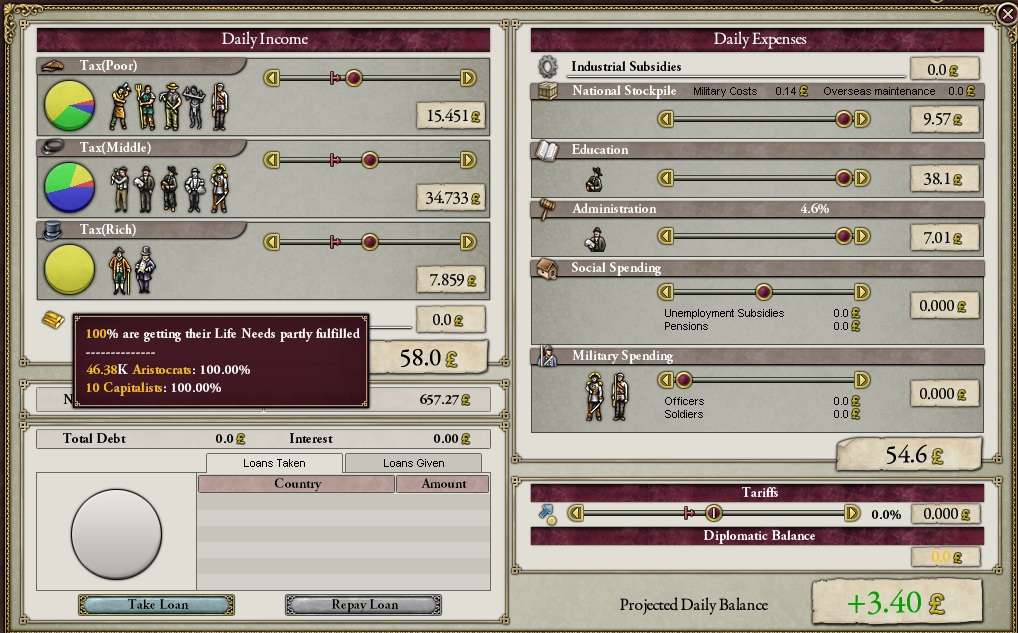
Here's our budget screen again. Notice the color of the pie next to the Rich tax rate? It's yellow. That means, as the tool tip shows, they're getting some -- but not all -- of their life needs. Every single Capitalist and Aristocrat in Ukraine has this problem, as the tool tip shows. Now, every POP has three levels of need -- Life, Everyday, and Luxury. If the pie is red, you're in a lot of trouble -- they're too poor to meet their life needs at all. Yellow means they can meet some, but not all, their Life Needs. Green is all their Life Needs, Dark Blue is all their Everyday Needs, and Light Blue is all their Luxury Needs. In a perfect world, all your POPs would have all their Luxury Needs all the time -- it is rarely a perfect world, however. POPs who don't get their Life Needs get very mad; they could also starve to death. POPs will do fine without Luxury Needs; they're Luxuries for a reason, and lots of Luxury Needs means you can often increase taxes, if you like. POPs won't get mad (or at least, not very mad) without Luxuries, but you should make every effort to get them Everyday Needs.
As we can see, however, our rich people can't fulfill their life needs, so we need to quickly see why that is and if we can fix it, or they'll die, leave, or rise up against us, none of which are desirable.
I've gone to the Population Screen and isolated Aristocrats and Capitalists. I suspect I know why they're mad, and you can see why. From left to right, though, this has good information.
The first few are all relatively easy to sort out, up to the little fireball. If a culture isn't accepted, you'll get a little militancy from those POPs. Religion isn't really a big deal in Vicky 2 -- it does create different POPs, but for the most part, religion isn't terribly divisive (some events do trigger because of it, and it can drive some elections). The little fireball is militancy. 0.00 means they couldn't be happier with life -- 10 means they're about ready to start shooting. The little head with the brain means CON -- in this case, the higher the better. The head with the speech balloon is ideology -- if you hover over it, you'll find out the break down. The bigger pies above show the same thing, but for all the POPs in question -- sometimes you'll want to know a single POPs ideology and issues if you want to know why they're mad. Issues, speaking of which, are the next box. When it comes to voting in the Lower House (when Ukraine is more democratic, we'll talk more then), POPs always vote by issue. Issues could be one plank of a party platform or a particular reform a POP wants. So, when you look at the big pie and see that 18.1% of the POPs are Pro Military, those POPs will choose the party that offers a Pro Military stance. For now, just note this and move on.
The little guy holding a scroll (I think?) is the unemployment gauge -- it's empty now, which is good, but it will turn red if there's unemployment. Craftsmen are almost always the only ones that trigger this. The pound sign is how much cash the POP makes each day -- you can hover over it to find out much they're spending, how much they pay you, and how much they just save for a rainy day. The three glasses -- water, beer, and wine -- represent the Life, Everyday, and Luxury Needs. As you can see, I've got the mouse pointer hovering over the Life Needs of one pop. You can see what the problem is -- Tea. We're way too far down the list and we don't produce our own Tea. As we move up the rankings, this will go away, but as yet, we can't do much of anything about it.
The last three columns are straightforward. The red and black flag is for rebels -- here you can find out what faction they're joining. By sorting by this, you can find out why they're mad and see if you can fix it -- a handy tip. The three arrows let you know if if the POP is growing (green arrow up), constant (yellow arrow straight) or declining (red arrow down). You can get more info from the tool tip here too, including specific numbers and why they're growing/declining (birth, death, immigration, emigration, etc.) Finally, the book is literacy rate. You can click on specific POPs if you want to know why they aren't promoting or demoting (changing jobs). You can engage in social engineering sometimes -- for now, we won't mess with that.
Clergy aren't getting max Life Needs for the same reason -- they want Tea too. Each type of POP has fixed needs and fixed quantities of those needs. If a good isn't available, you just have to suck it up, add a country that produces that to your sphere, conquer one and take their RGO, or just wait until your Total Score improves.
February 21, 1837: France annexes Tunis -- no surprise there.
June 1, 1837: We start building a naval base in Odessa. Like Factories, you pay a fixed cost, plus buy the inputs -- in this case, Timber, Steel, Cement, Lumber, and Machine Parts. Unlike factories, once it's up, it's up, and there's no maintenance cost! Naval bases perform two key functions -- they increase your colonization range (not hugely important now) and help with shipbuilding (you can fix ships and build new ones faster). They take a long time to build -- 1081 days (about three and a half years) -- but a naval power can't survive without them. Kerch will get one too.
June 25, 1837: Greece gets a hold of us -- they want to be Ukraine's friend. I pass here -- Ukraine isn't ready for war, and they aren't friendly with Russia.
August 20, 1837: Drat!

Russia broke their alliance with us -- we'll try to beef up relations so other countries don't get a notion to attack us. Austria and the Ottoman Empire get nice notes, improving relations -- like EU 3, there's a sliding scale of +200 to -200 -- but nobody wants to be Ukraine's protector

September 23, 1837: Here's a good time to show you the production screen. We need to make a decision on Kiev.
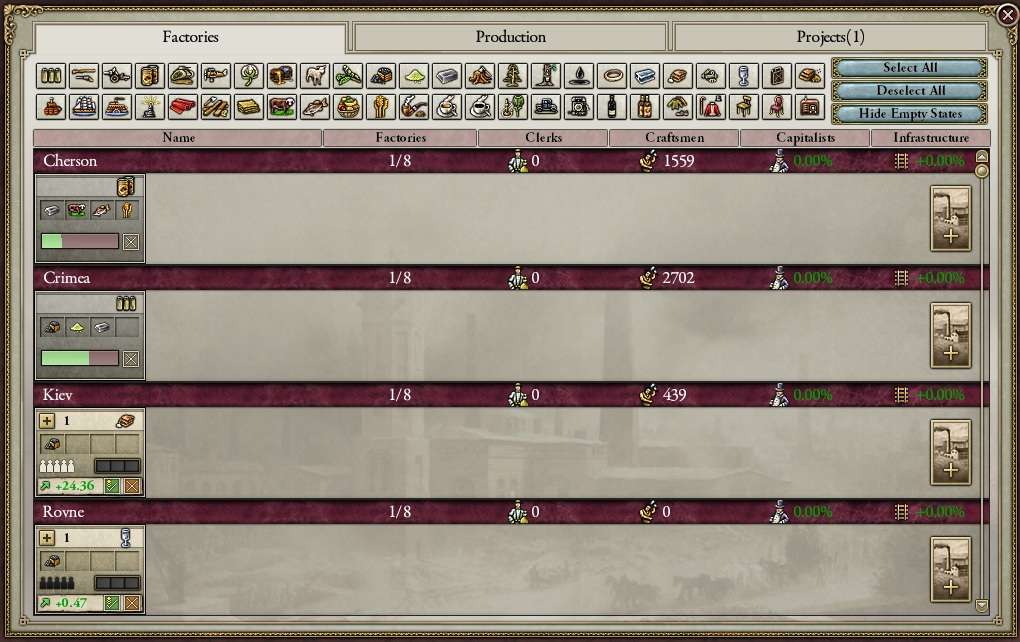
You can hover over stuff on each factory to find out how much you're paying in maintenance (the capitalist, anyways), how much you pay for inputs, and how much output you get. A quick overview here: Name is the Name of the State (not the Province; they're pretty much randomly allocated throughout the state); Factories is how many you have in the state (all of them can have no more than 8), Clerks and Craftsmen are how many you have of each that are unemployed, Capitalist is a percentage of how much efficiency the capitalists add to the factory, and Infrastructure is railroads, which add a further bonus to production. Each factory shows, at a glance, what it makes, how many people it employs, what you need to make the output, how much money it makes (if it's green, it's profitable, if it's yellow, it breaks even, if it's red, it's going broke), if it's subsidized or not (the green checkbox), and an "X" to close the factory. However, we're concerned about that little + in the upper left corner of the Kiev cement factory. As you can see, we've got some unemployed workers in Kiev. A level 1 factory can hold 10,000 craftsmen/clerks. You can upgrade a factory (up to level 99), so it can hold more workers and produce more. It's cheaper and quicker than building a new factory, and if it's profitable, can sometimes be a great decision.
Here's what I asked myself -- do I want to build a new factory in Kiev or do I want to upgrade the Cement factory? Now, I thought about building a Winery there. However, it would take a really long time for that to finish (two years) and unemployed workers are mad workers. So instead, we upgrade the Cement factory. Besides choosing to upgrade, you can also change subsidies, close or open the factory, or set priorities, depending on your economic system. We have State Capitalism, so we can do any or all of them (default is no priorities and yes to subsidies). I will eventually unsubsidize factories that are going broke. I only adjust priorities (first crack at labor and inputs) to critical industries or to get some factories started. For now, I leave them all alone. I do however build that Winery, but in East Galicia. It doesn't matter if you have fruit in the state or not to build the Winery -- it's just a matter of getting people to work faster with the upgrade. Plus, I'm sure the capitalists will buy us some more factories in Kiev.
October 19, 1837: After I fixed my little problem with the save, I noticed I got a second NF (more Ukrainians from the lost territories). We'll encourage Clergy in Crimea.
December 14, 1837: That factory buying caused us to take an auto-loan. We repay it immediately -- it's not going to cripple an economy, but it's always better not to pay the interest.
January 17, 1838: Looks like the Ukrainian Daily Telegraph (not an actual Ukrainian newspaper) is posting some salacious gossip! I want to encourage political reforms, and convincing Ukrainians to agitate for a free press will help.
March 1, 1838: Ukrainian economists finish the concept of Freedom of Trade. How big a difference is this? Well, we start with 11.9 pounds/day surplus. In two weeks, we're up to 40 pounds/day, almost quadrupling our economy! I thought seriously about choosing Idealism or Medicine at this point, but Clean Coal is just too good to pass up for Ukraine -- a boost of 75% to coal production, with mine sizes increasing by 20% should be a huge boost to the economy. Plus, it'll help us make more of our tiny iron ore deposits.
April 12, 1838: With a fairly stable profit base, we cut taxes for the middle class to 45%.
September 28, 1838: I notice a huge drop in the economy, and I haven't built anything new or started any wars -- this must mean the bottom has dropped out of one of my industries. I look at the production screen -- it's that stupid Ammunition Factory that the Capitalists built in Crimea. I'd de-subsidize it -- that's why my economy dropped, I'm paying almost 20 pounds a day to keep it afloat -- but then I'd have a bunch of unemployed workers. Fortunately, the capitalists made a good decision and started a glass factory -- if that gets closer to completion, I'll let the free market take care of the Ammo Market. I didn't check, but I suspect we're doing badly with this factory because we don't have Sulfur. It's also possible that Ammo is just overproduced.
I also discover a little mistake I made -- I was so taken with the new Winery I built earlier that I never upgraded the Cement Factory in Kiev! I do that now -- fortunately, a Steel Factory is almost done, so some Craftsmen will go there. Steel sometimes does very well -- I have a feeling it won't do well for Ukraine, since I don't have Iron Ore, but anything is possible. It's an important industrial good -- all factories need it and your nicer ships do too -- but it's another one that tends to get overproduced.
December 19, 1838: Ukraine now ranks #14 in the world, thanks to our factories! We're officially a Secondary Power! It won't last, but it's nice to know we've already come a long way.
January 1, 1839: I haven't been updating the Upper House for you guys (no reforms yet). Here, we notice that society is polarizing a bit; the Conservatives lose 9% and the Liberals gain 6.5%, with the rest going to the Reactionaries. We're nowhere near the 50% threshold, still less than 20% for the Liberals (and the Conservatives are by far the largest party), but we could get big boosts to Liberals soon.
April 17, 1839: The Ottoman Empire bites off a piece of Egypt. Egypt is another area I'd expand in, if I had the fleet and army to do it -- for now, I shake my fist impotently and wait for the economy to truly explode.
June 28, 1839: As a test, I try building some infantry -- looks like I'll get blocked out of the Small Arms market, so it's a no go. Soon, though, I hope we'll start making inroads.
August 13, 1839: We're struggling to have a big surplus. First, I build a new Cement Factory in Cherson. However, the economy is doing quite well, and it might be a good time to change some policies to kick it into high gear.
Here are the two economic systems we're considering -- we have State Capitalism and are mulling over Laissez-Faire.
There are a few changes to highlight. First, the cost of factories drops by quite a bit -- from +200% to +100%, or cut in half. Second, we go from a slight penalty to production to a mild bonus to production. Third, we can cut taxes more if we like -- we go from a minimum of 25% to a maximum of 50%. However, for a time, we'll lose control over the economy entirely. No subsidies, no priorities, no building factories, none of that. The bonuses are worth it, but for at least a year (you can only chance Ruling Parties once a year, or if an election changes it), we're stuck with the Laissez Faire crowd. We'll give it a try -- let's see how the computer does on its own.
Here are the other changes:
Trade Policy -- Protectionism. A maximum of 100% to tariffs, minimum of -25%. I don't mess a lot with tariffs, but if I do, I like me some import subsidies. You can't really use tariffs to support your industry; your POPs always buy from the domestic market anyway -- but import subsidies can help industry by making foreign goods more available.
Religious Policy -- Pluralism. Religious policies are mostly flavor -- they'll rarely be a big enough issue to have people vote solely on religion.
Citizenship Policy -- Full Citizenship. If this were truly a voting republic (it isn't yet), all citizens, regardless of culture, can vote.
Military Policy -- Pacifism. The one reason I hate the Ukrainian Liberals. Max of 50% defense spending -- you don't pay as much for supply costs, but Pacifism also ratchets up War Exhaustion. Ugh.
We'll let this work for a while and see how it goes.
September 3, 1839: Looks like a winner -- so far, we've gone from a surplus of two pounds a day to nearly 40 pounds a day! We do have some unemployment from factories going bankrupt -- I can't do anything about that, though.
October 1, 1839: The Russians are now Friendly to us. Yes! I can practically taste that sweet Russian timber!
November 8, 1839: With this huge surplus, we institute import subsidies. Here's how they work.
You set the Tariff slider to a negative number -- in this case -25%. Let's go back to our timber example. Domestic prices are unchanged. However, let's say our POP buys 1 unit of Timber for 10 pounds. He actually only pays 7.5 pounds -- I, the government, pay the extra 2.5 pounds.
I did this to help those rich folks buy tea; I'd like to be on their good side.
January 1, 1840: We're just about done with this update! First, the upper house took away some of our liberals. 63% conservative, 20% reactionary, 17% liberal. With some people out of work, Capitalists are making less money. Less money means they don't quite get their needs, and they start voting the opposite way. That probably explains the drop. It's not a big one, but it is a concern.
We'll close with two screen shots. Here is Ukraine's provinces, sorted by total income (this is RGOs only):
Looks like Poltava's coal mines are doing very nicely. Pleased to see Fruit doing well -- when the factories get going, you'll see this do even better!
Here are factories (now, this is by State, not by province):
Look at our Cement Factory go! The four factories making nothing are all bankrupt -- I think Laissez Faire was a mistake. We'll have to see how it goes in the remaining time, but I already think I'm leaning towards another party.
If you'd like to amuse yourselves until the next update (it might be a while -- this one took a long time!), guess which party I'll pick! You can look at the Intro to see my three options.
Sorry again for so much text, but we had a lot of explaining to do. I'll try to keep those for tutorials in the future!
 ) and partially to accomplish a few goals.
) and partially to accomplish a few goals.



